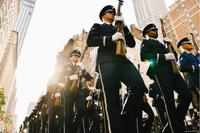James C. Roberts is president of the American Veterans Center.
In the course of heading the American Veterans Center for the last 20 years, it has been my privilege to get to know a multitude of our country's military heroes.
As we commemorate V-E Day (Victory in Europe Day, May 8, 1945), one of these heroes stands out: Army 2nd Lt. Leonard "Bud" Lomell.
Then-1st Sgt. Lomell is indelibly connected to a second famous date: June 6, 1944 -- D-Day, the day American, British, Canadian and other Allied forces landed at Normandy on the French coast to begin the Liberation of Europe.
Without the success of the Normandy landings, there would likely never have been a V-E Day.
The D-Day landings were a massive undertaking -- possibly the largest the world will ever know -- comprising 7,000 ships and landing craft, 50,000 vehicles, 11,500 airplanes, and 156,000 troops. It was accomplished against great odds, including difficult weather and heavy seas.
Looking back on this near-miracle, historian Stephen Ambrose wrote that if he had to select one man most responsible for the success of D-Day, besides Gen. Dwight D. Eisenhower, the supreme allied commander of the operation, it would be Leonard Lomell.
Lomell, the adopted son of Scandinavian immigrants, was raised in New Jersey and was a stand-out scholar-athlete in college before volunteering for Army service in World War II. He was selected for Ranger duty and shipped to England with tens of thousands of other green Army troops to prepare for the invasion of Europe.
On D-Day, as acting commanding officer of D Company, 2nd Ranger Battalion, Lomell's orders were to lead his men in scaling the cliffs of Pointe du Hoc between Omaha and Utah beaches in Normandy. He was tasked with taking out five 155mm guns that the Germans had emplaced at the top of the cliff in a location from which they could have inflicted catastrophic damage on allied ships, and on men landing on Omaha and Utah beaches.
The landing craft carrying Lomell and his men arrived more than a half hour late, far from its designated position, and 20 feet off shore. Loaded down with heavy equipment, the men had to swim to the beach.
Lomell was hit on the side by a machine-gun bullet but continued on to the beach. Under withering time, Lomell and his men somehow scaled the cliffs at Pointe du Hoc and, after hand-to-hand fighting, ran to the gun emplacement only to discover that the Germans had removed the massive guns and replaced them with telephone poles.
After stationing his men along the roadway to attack German reinforcements, Lomell and Staff Sgt. Jack E. Kuhn went in search of the guns.
They discovered them about one mile inland, camouflaged, in an orchard and pointed toward Utah Beach, but capable of being re-sighted on Omaha Beach.
With the Germans well off to the side getting a briefing from their commanding officer, Lomell placed silent thermite grenades in the gear mechanisms of the four guns and smashed a fifth's gunsite, thus putting the guns out of action.
The 2nd Ranger Battalion became the first American unit to accomplish its mission although, when they were relieved several days later, only 90 Rangers out of 225 had survived.
Lomell went on to further heroic action, leading the capture of Hill 400, a key German Command post in the Hürtgen Forest, where he was badly wounded, and in the Battle of the Bulge -- where he was wounded again.
In December 1945, seven months after V-E Day, a heavily battered but highly decorated 2nd Lt. Leonard Lomell was honorably discharged, having done more to make V-E Day possible than almost any other veteran of World War II.
-- The opinions expressed in this op-ed are those of the author and do not necessarily reflect the views of Military.com. If you would like to submit your own commentary, please send your article to opinions@military.com for consideration.















